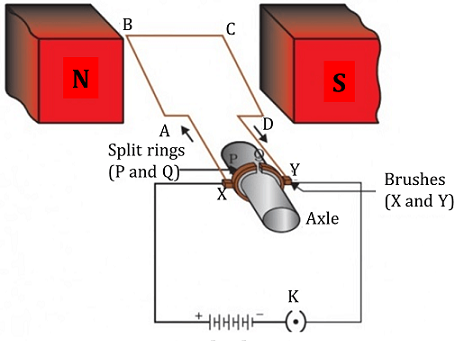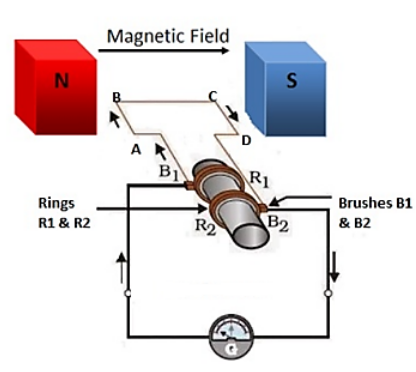Quick actions
Stay organised
Bookmark tricky derivations, add doubts to your dashboard, and revisit them before tests.
Open dashboard →NCERT Solutions for class 10 Science Chapter 13:Magnetic Effects of Electric Current
Review "Magnetic Effects of Electric Current" with concise NCERT answers and quick tips.
Exercise Question
Question 1
Which of the following correctly describes the magnetic field near a long straight wire?a) The field consists of straight lines perpendicular to the wire.
b)The field consists of straight lines parallel to the wire.
c )The field consists of radial lines originating from the wire.
d)The field consists of concentric circles centered on the wire.
Answer
d. The field consists of concentric circles centered on the wire.
Question 2
The phenomenon of electromagnetic induction isa)the process of charging a body.
b)the process of generating magnetic field due to a current passing through a coil.
c)producing induced current in a coil due to relative motion between a magnet and the coil.
d)the process of rotating a coil of an electric motor.
Answer
c. producing induced current in a coil due to relative motion between a magnet and the coil.
Question 3
The device used for producing electric current is called aa)generator
b)galvanometer
c)ammeter
d)motor
Answer
a. generator
Question 4
The essential difference between an AC generator and a DC generator is thata)AC generator has an electromagnet while a DC generator has permanent magnet.
b)DC generator will generate a higher voltage.
c)AC generator will generate a higher voltage.
d)AC generator has slip rings while the DC generator has a commutator.
Answer
d. AC generator has slip rings while the DC generator has a commutator.
Question 5
At the time of short circuit, the current in the circuita)reduces substantially.
b)does not change.
c)increases heavily.
d)vary continuously.
Answer
c. increases heavily
Question 6
State whether the following statements are true or false.a)An electric motor converts mechanical energy into electrical energy.
b)An electric generator works on the principle of electromagnetic induction.
c)The field at the center of a long circular coil carrying current will be parallel straight lines.
d)A wire with a green insulation is usually the live wire of an electric supply.
Answer
a. False
b. True
c. True
d. False
Question 7
List two methods of producing magnetic fields.Answer
Following are the methods of producing magnetic fields:
By using a permanent magnet we can produce magnetic field and it can be visualized by spreading iron fillings on a white paper and keeping a magnet beneath the paper.
A current carrying straight conductor produces magnetic field.
Different types of conductors such as solenoid and circular loop can be used to see the presence of magnetic field.
Question 8
How does a solenoid behave like a magnet? Can you determine the north and south poles of a current–carrying solenoid with the help of a bar magnet? Explain.Answer
A coil of many circular turns of insulated copper wire wrapped closely in the shape of a cylinder is called a solenoid. When the current is passed through a solenoid a very strong magnetic field is produced and behaves like a strong bar magnet.
Yes,We can determine the north and south poles of a current carrying solenoid with the help of a bar magnet. When north pole of bar magnet is brought near the end of the solenoid and if magent is repels ,the ends is north end of solenoid else the end is south end of solenoid .
Question 9
When is the force experienced by a current–carrying conductor placed in a magnetic field largest?Answer
The largest force experienced by a current–carrying conductor when the direction of the current is mutually perpendicular to the direction of the magnetic field .
Question 10
Imagine that you are sitting in a chamber with your back to one wall. An electron beam, moving horizontally from back wall towards the front wall, is deflected by a strong magnetic field to your right side. What is the direction of magnetic field?Answer
The negatively charged electrons move from the back wall to the front wall That means The direction of the current is from the front wall to the back wall . Since partical deflect toward right side means direction of force toward right side .So using Fleming’s left hand rule we can find the direction of the magnetic field towards downward direction
Question 11
Draw a labelled diagram of an electric motor. Explain its principle and working. What is the function of a split ring in an electric motor?Answer

Principle: :when a rectangular coil is placed in a magnetic field and current is passed through it, a force acts on the coil which rotates it continuously.
Working: Current in the coil ABCD enters from the source battery through conducting brush X and flows back to the battery through brush Y. the current in arm AB of the coil flows from A to B. In arm CD it flows from C to D, that is, opposite to the direction of current through arm AB. On applying Fleming’s left hand rule for the direction of force on a current-carrying conductor in a magnetic field the force acting on arm AB pushes it downwards while the force acting on arm CD pushes it upwards and it rotate anti-clockwise. At half rotation, Q makes contact with the brush X and P with brush Y. the current in the coil gets reversed and flows along the path DCBA. The reversal of current also reverses the direction of force acting on the two arms AB and CD. so it pushed down. Therefore the coil and the axle rotate half a turn more in the same direction. The reversing of the current is repeated at each half rotation, giving rise to a continuous rotation of the coil and to the axle
Split ring is used reverses the direction of the current flowing through the coil after each half rotation of the coil. Due to this reversal of current, the coil continues to rotate in the same direction.
Question 12
Name some devices in which electric motors are used.Answer
Electric fans
Water pumps
Mixers
Washing machines
Refrigerator
Question 13
A coil of insulated copper wire is connected to a galvanometer. What will happen if a bar magnet is (i) pushed into the coil, (ii) withdrawn from inside the coil, (iii) held stationary inside the coil?Answer
(i) A current is induced in the coil When a bar magnet is pushed into the coil as a result deflects produce in galvanometer .
(ii) A current is induced in the coil When a bar magnet is withdrawn from inside the coil but in the opposite direction and the galvanometer deflects in the opposite direction .
(iii) No current will be induced When a bar magnet is held stationary inside the coil as a result there will be no deflection in the galvanometer.
Question 14
Two circular coils A and B are placed closed to each other. If the current in the coil A is changed, will some current be induced in the coil B? Give reason.Answer
Yes, A induced current is produce in the coil B. When the current in coil A changes, the magnetic field of coil A also changes. As a result the magnetic field around coil B will change. The change in the magnetic field of coil B induces current in it.
Question 15
State the rule to determine the direction of a (i) magnetic field produced around a straight conductor-carrying current, (ii) force experienced by a current-carrying straight conductor placed in a magnetic field which is perpendicular to it, and (iii) current induced in a coil due to its rotation in a magnetic field.Answer
(i) Maxwell’s right hand thumb rule.
(ii) Fleming’s left hand rule.
(iii)Fleming’s right-hand rule.
Question 16
Explain the underlying principle and working of an electric generator by drawing a labelled diagram. What is the function of brushes?Answer

Principle:It is base on principle of electromagnetic induction such that when a straight conductor is moved in a magnetic field then current is induced in conductor
Working: The rotating the loop in a magnetic field, the side AB moves upward and the side CD moves downwards respectively in the produced magnetic field. Thus, current is induced in it whose direction can be determined by Flemings right hand rule. After half rotation, the ring P comes in contact with brush Y and the ring Q, comes in contact with brush X. Thus, the brush X is always in contact with the side moving upwards and brush Y is always in contact with side moving downwards as a result of which the current flows in one direction. This current is called direct current. This type of generator is called D.C. generator. Similarly, instead of a half ring, if a full ring is used then, A.C. current can be generated and such a generator is called an A.C. generator.
Function of brushes help in transferring current from coil to the external circuit.
Question 17
When does an electric short circuit occur?Answer
electric short circuit occur when the live wire and the neutral wire come into direct contact. This occurs when the insulation of wires is damaged or there is a fault in the appliance
Question 18
What is the function of an earth wire? Why is it necessary to earth metallic appliances?Answer
The earth wire used as a safety measure, especially for those appliances that have a metallic body, for example, electric press, toaster, table fan, refrigerator, etc. The metallic body is connected to the earth wire, which provides a low-resistance conducting path for the current. Thus, it ensures that any leakage of current to the metallic body of the appliance keeps its potential to that of the earth, and the user may not get a severe electric shock.
Chapter shortcuts
- Chapter 1 · Chemical Reaction And Equations
- Chapter 2 · Acids, Bases and Salts
- Chapter 3 · Metals and Non-metals
- Chapter 4 · Carbon and Its Compounds
- Chapter 5 · Periodic Classification of Elements
- Chapter 6 · Life Processes
- Chapter 10 · Light Reflection and Refraction
- Chapter 11 · Human Eye and Colourful World
- Chapter 12 · Electricity
- Chapter 13 · Magnetic Effects of Electric Current
- Chapter 14 · Sources of Energy
- Chapter 15 · Our Environment
- Chapter 16 · Sustainable Management of Natural Resources